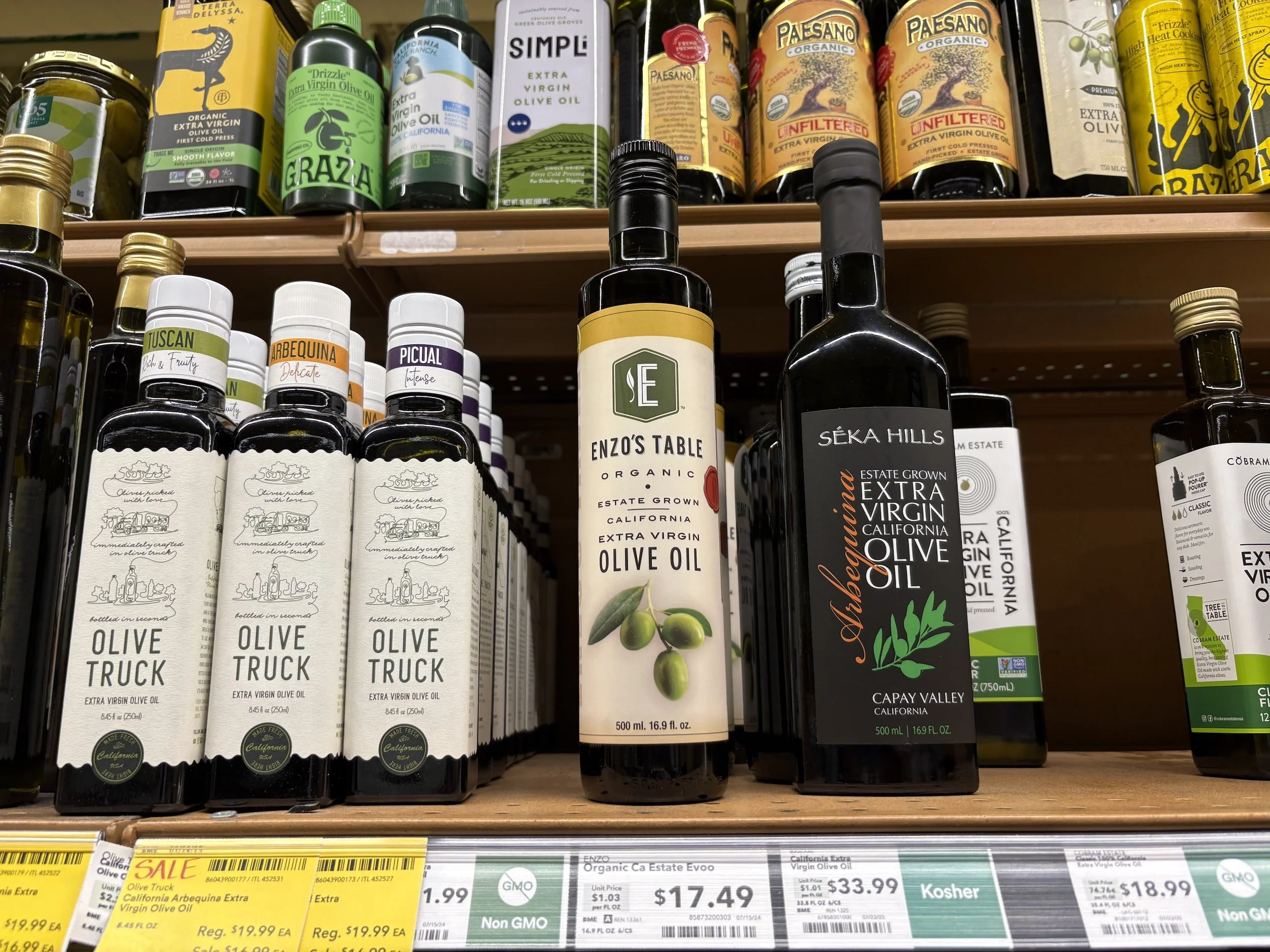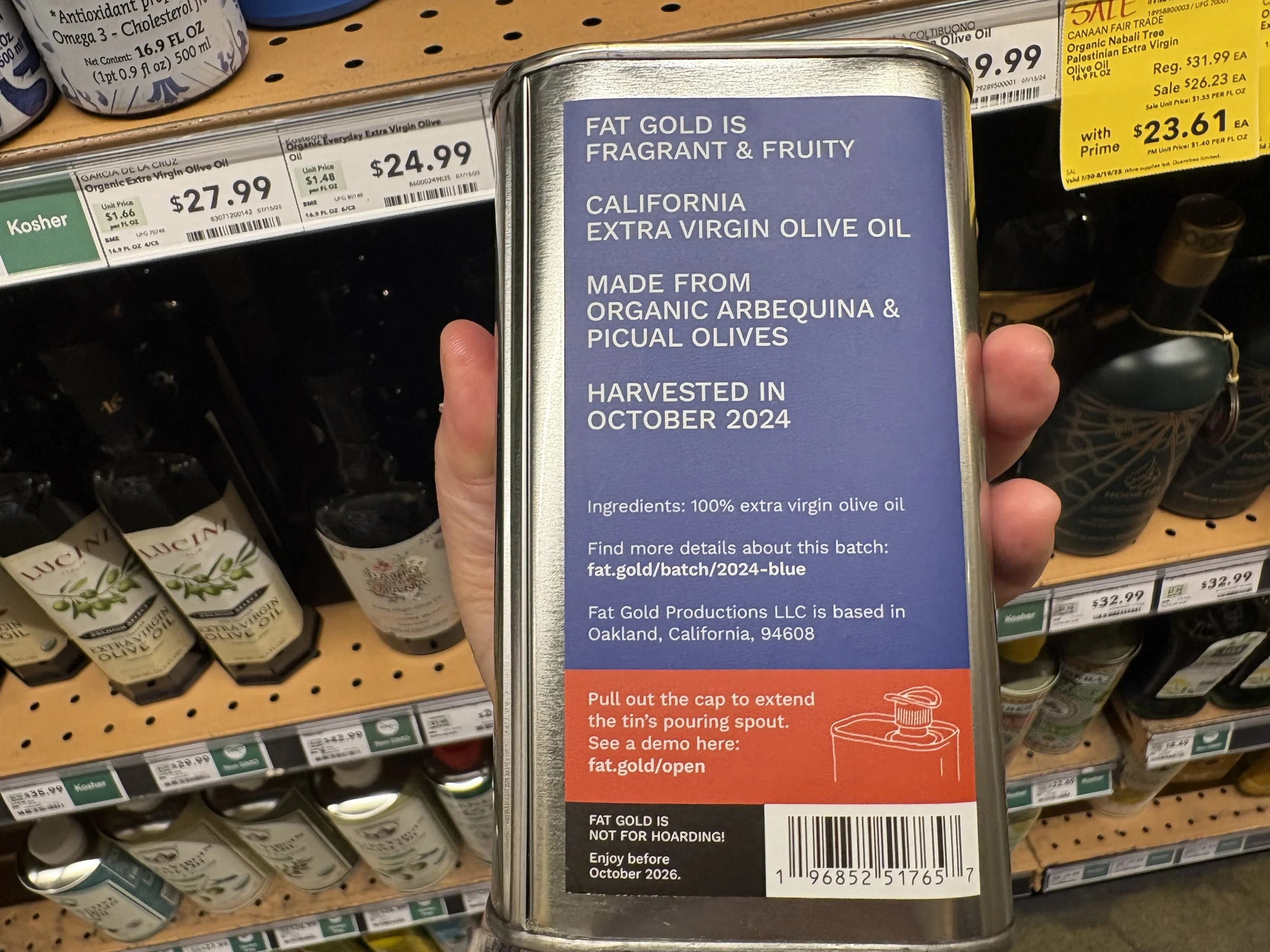How to Shop for Great Olive Oil
Olive oil bottles on supermarket shelf
Olive oil's moniker as “liquid gold” has never rung truer. But due to various factors, shoppers are getting sticker shock as they peruse bottles of this Mediterranean kitchen must-have. Even when price isn't an issue, reading a label can be confusing to say the least, especially if you don't know what you should be looking for.
It’s more important than ever to know what kind of olive oil bang you’re getting for your buck. So, we brought in three olive oil experts to help decipher what’s important when selecting olive oil and what is just good marketing.
Certifications
David Garci-Aguirre, Master Miller at Corto Olive Oil
Everyone places a lot of weight on whether a fancy label says the oil is “extra virgin.” “There exists a huge disconnect between what consumers think they bought (top quality) and what they actually get (commodity, low quality),” says David Garci-Aguirre, Master Miller at Corto Olive Oil. “The criteria for an oil to be extra virgin are pretty low. The only requirement is that there cannot be anything wrong with it. It’s like getting a D in school. You passed, but you didn’t do anything particularly well.”
Instead, Garci-Aguirre says look for special seals. “Seal certifications like the California Olive Oil Council, and new terms like extra, extra virgin, beyond extra virgin, etc., are an attempt to distinguish honestly fresh, high-quality olive oil from an extra virgin category that has become dominated by commoditized low-quality oil.” Outside of California, look for certifications such as Organic and the European Union's Protected Designation of Origin (PDO). (Read more about California certifications).
Harvest Date
Matteo Frescobaldi, manager of Laudemio Frescobaldi
First, look for a harvest year, aka vintage, on the label, advises Matteo Frescobaldi, manager at Laudemio Frescobaldi. “This shows that the oil comes from a single harvest, ensuring freshness and flavor. Oils without a vintage may contain blends from different years, which are typically less vibrant,” he says.
Frescobaldi also insists that the most recent harvest is the best. So, right now, look for 2024. “In a few months, you may begin seeing harvest 2025 oils. In the Northern Hemisphere, olive harvest takes place in October and November, so new-season oils typically reach the market between December and January, depending on transport and bottling,” he says.
Single Origin
Jeremy Sernick, Founder and CEO of Oliva Dorado
Don’t be fooled by a bottle reading “Italian olive oil,” warns Jeremy Sernick, Founder and CEO of Oliva Dorado. Instead, turn it over and check whether the olive oil was made from olives from multiple countries, such as Spain, Tunisia, Turkey, and Italy.
“When olive oil comes from one farm, it is usually the result of small-batch production focused on quality, using only olives grown on that same farm,” he says. So instead, look for words like single-origin or single-estate.
Glass or Tin Container
Olive oil tin with harvest date
All of our experts agree that olive oil should be stored in a dark glass bottle and should be kept away from light, heat, and air. “Olive oil sitting in plastic for long periods of time, such as in warehouses, on shelves, in transit, can potentially lead to microplastics leaching into the bottles, which is something I try to avoid,” says Sernick.
Region? Maybe
Olive trees in Tuscany
While some stalwarts will only buy Italian Extra Virgin Olive Oil, experts aren’t as picky. “Traditionally, authentic Italian extra virgin olive oils are among the best. However, excellent EVOOs are now produced around the world—as long as they meet those same high standards,” says Frescobaldi.
Garci-Aguirre agrees. “Like great wine or cheese, there are fantastic oils produced all over the world. I would never recommend that someone limit their olive oil experience to one region,” he says.
Things To Avoid
Of course, there are some major red flags when it comes to olive oil. The best way to tell if an oil is off is by using your senses. “If the oil is opaque or cloudy, this usually means it wasn’t properly filtered or extracted,” says Frescobaldi. The best shops will allow you to sample oil before you buy. He also says to avoid oils with a musty aroma or no hint of fruitiness. “A high-quality EVOO should have fresh, pleasant aromas reminiscent of healthy green olives.”
And when it comes to taste, he says, “Poor-quality oils taste flat, fatty, or rancid. A good EVOO should evoke the freshness of fruits and vegetables—think green tomato, artichoke, or wild rocket—with a pleasant balance of bitterness and spiciness.”






